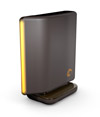Seagate FreeAgent Desktop and the iMac
 I just bought a FreeAgent Desktop 320GB external hard drive for doing backups. I generally trust Seagate drives these days; I’ve bought plenty over the years and had no problem with them, so they seemed like a safe bet. The 5-year (admittedly extremely limited) warranty helped to some extent too.
I just bought a FreeAgent Desktop 320GB external hard drive for doing backups. I generally trust Seagate drives these days; I’ve bought plenty over the years and had no problem with them, so they seemed like a safe bet. The 5-year (admittedly extremely limited) warranty helped to some extent too.
I was a little apprehensive about the orange glowing light on the unit, as I have the iMac in our bedroom and the backups run overnight. What’s more, you can’t turn it off except via the FreeAgent Pro software (which you pay extra for!). However it’s not too offensive in practice; I keep it hidden under my desk and it behaves itself.
When I first connected the drive I had to reformat it for the iMac using Disk Utility, but after that it just appeared as a USB drive in the Finder. Too easy.
The drive’s nice and quiet too. The glowing light pulsates gently when there’s disk activity, which is very sci-fi, and not as distracting as normal activity lights.
The only problem so far is that it prevents the iMac from going into a scheduled sleep. This only seems to happen on nights when it’s done a backup. The iMac’s scheduled to sleep in the middle of the night, but instead it stays on, and then at some random time in the morning it starts trying to go to sleep! Very pesky. I’m not sure what’s going on there. On the plus side, when I sleep the iMac manually in general use, the drive powers down too (and turns off its orange glowy light).
Pros and cons, then, of the FreeAgent with the iMac.
Pros:
- Cheap (but most external drives are these days)
- Chocolate-and-amber styling’s OK, if you like that sort of thing
- Quiet
- Easy to install
- Seems fast enough
Cons:
- No way to turn off the amber light (that I could find anyway)
- Sometimes stops the iMac from sleeping
- Comes with a separate “wall wart” power supply; powered from USB would have been nice.









October 11th, 2007 at 10:12 pm
I don’t know of many, if any 3.5inch drives that are powered by USB. Plus I’m pretty sure that when Macs sleep, power is cut from the USB ports. Having a separate wall wart is probably better for the drive anyway.
Also, you will nearly always have problems with USB devices causing problems with sleep. This is because these devices are often active even when the computer is asleep. USB devices can, and often do cause wake events. My girlfriend’s scanner for example, likes to cycle its power/connection every 30 mins or so when on.. this always causes her iMac to wake up.. very annoying. Unfortunately there isn’t a power switch on the scanner itself, the only way to turn it off is to fish around for the plug and pull it from the socket.
The solution? Unplug these rogue USB devices. Irritating yes. But your Mac will sleep without interruption.
Alternatively..
I have two Lacie FireWire drives sitting underneath my Intel Mac mini, and it sleeps beautifully. I assume this is because of the differnces between FIreWire and USB. In my opinion FireWire is far superior to USB in many ways. I would always recommend FW over USB.
October 15th, 2007 at 7:55 pm
Thanks for the tips Gideon. I think I’ll try changing my backup script to unmount the drive after the backup finishes. Maybe then the drive will auto-power-down, which will in turn let the Mac sleep. Worth a try!
October 16th, 2007 at 12:06 am
Good idea.. hope it works!
December 14th, 2007 at 3:51 am
I have an iMac and I am looking for a large external drive. I think I will go with the seagate!
Hopefully it will work fine!
Francesco
January 22nd, 2008 at 10:01 am
I have one too. Works realy well, verry good USB 2.0 transfer, aprox 20mb/s and tops all my other internal HDDs. I also noticed the HDD shuts down if you don’t use it. It only takes 3-4 sec restart. It’s a verry good way to keep the HDD alive longer. Even if it has 5 year warranty, I’m confident it will not break.
Also I wanted to say that a power supply si a MUST. USB will probably not hold this much current. Not to mention the fact that USB has only 5V, and a full size HDD requires 12V and 5V, probably a total of 2A. Some motherboards can’t even power a small laptop HDD that requires 5V @ 0.5A.
Looking foreward to get another one.